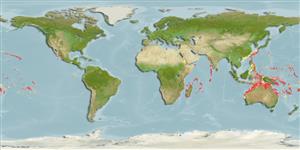分類 / Names
俗名 | 同種異名 | Catalog of Fishes (gen., sp.) | ITIS | CoL | WoRMS | Cloffa
Actinopterygii
輻鰭魚綱 (條鰭魚) >
Tetraodontiformes (Puffers and filefishes) >
Tetraodontidae (Puffers) > Canthigasterinae
Etymology: Canthigaster: Greek, kanthos = the outer or inner corner of the eye, where the lids meet, 1646 + Greek, gaster = stomach (Ref. 45335).
環境 / 氣候 / 範圍
生態學
; 海洋 礁區魚類; 深度上下限 6 - 165 m (Ref. 83660). , preferred ?; 30°N - 30°S
Former distribution of Hawaii and Tonga to the east coast of Africa and the Red Sea, is divided into three species: C. coronata, endemic to the Hawaiian Islands;
C. axiologus from the rest of the Pacific west of the Hawaiian Island; and
C. cyanospilota from the Indian Ocean and Red Sea (type locality, Gulf of Aqaba) (Ref. 83660).
大小 / 重量 / 年齡
Maturity: Lm ? range ? - ? cm
Max length : 11.0 cm SL 雄魚/尚未辨別雌雄; (Ref. 83660)
背棘 (總數): 0; 背的軟條 (總數): 9-11; 臀棘 0; 臀鰭軟條: 9 - 10. This species is characterized by the following: D 9-11 (usually 10, rarely 9); A 9-10 (usually 10); pectoral rays 15-18 (usually 17); gill rakers 7-9; body depth between origins of dorsal and anal fins 2.8-3.25 in SL; head length (HL) 2.3-2.55 in SL; interorbital width 3.9-4.45 in HL; gill opening 3.7-4.75 in HL; anal fin origin below or anterior to rear base of dorsal fin, preanal length 1.35-1.4 in SL; longest dorsal ray 2.2-2.5 in HL; preserved colour pale grey to pale tan with 3 triangular dark brown saddle-like bars dorsally on body, progressively more oblique posteriorly, the first extending narrowly to ventral edge of gill opening, the second to level of lower edge of pectoral-fin base and enclosing base of dorsal fin posteriorly, and the last ending at upper base of caudal fin; a dark brown band run across posterior interorbital and anterior occiput; a dark brown spot below base of pectoral fin; head and body with many small pale spots (most about half pupil diameter), faint or absent on paler parts of body but very evident on edges, within dark bars, and on head where ground colour darker; around eye are narrow pale bands and spots; pale lips encircled with a narrow dusky band; a thin dark brown line midventrally on abdomen and chest present or absent (may be broken to long segments); pale fins, with upper and lower margins of caudal fin with a broad brown band, darker at base; when fresh, noteworthy are the many small yellow spots, and the lack of blue spots - blue only between yellow markings around eye (Ref. 83660).
Found mostly below depths of 23 m, but occasionally seen in as little as 6 m (Ref. 3921). Benthopelagic (Ref. 58302). Usually found on sand or sand and rubble bottom or algal flats, often in the vicinity of coral reefs (Ref. 83660). Feed on a wide variety of benthic organisms: gastropods, sponges, algae, bivalves, polychaetes, tunicates, crabs, sea urchins, heart urchins, brittle stars, bryozoans, peanut worms, various small crustaceans and foraminiferans (Ref. 3921).
Life cycle and mating behavior
成熟度 | 繁殖 | 產卵場 | 卵 | 孕卵數 | 仔魚
Randall, J.E., J.T. Williams and L.A. Rocha, 2008. The Indo-Pacific tetraodontid fish Canthigaster coronata, a complex of three species. Smithiana, Publ. Aquatic Biodiv. Bull. 9:3-13. (Ref. 83660)
CITES (Ref. 94142)
Not Evaluated
人類使用
水族館: 商業性
更多資訊
參考文獻養殖養殖資訊品種遺傳學基因序列遺傳率疾病加工Mass conversion
工具
特別的報告
下載 XML
網路資源
